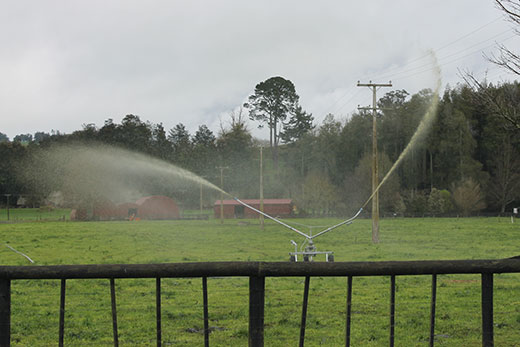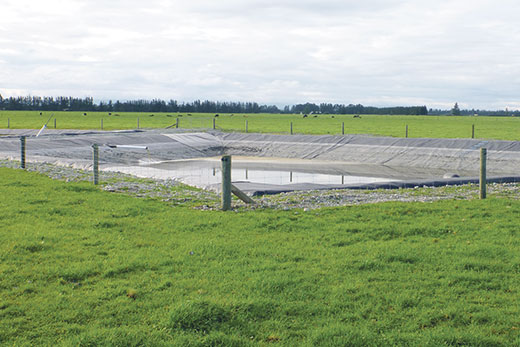Soils with good populations of their own healthy and hungry “livestock” can probably treat dairy effluent almost indefinitely, dramatically reducing nutrient leaching to waterways.

That’s among the views of a number of experts and advisors canvassed by Coast & Country for their opinion on the long term ability of soils to treat effluent.
Regional councils require farmers to store dairy shed effluent and apply it at prescribed rates, onto pasture when weather conditions are favourable; but just how effectively and for how long soils can keep doing this, we asked.
Ants Roberts Chief Scientific officer for Ravensdown says so long as the soil is fully functioning biologically, there should be no accumulation of effluent.
“Soils have an enduring ability to treat effluent and they will largely prevent nutrients reaching water ways. In one to two days, in ideal conditions, nothing of the effluent is left.”
Phyllis Tichinin General Manager of True Health says soils with thriving microbial communities can gradually expand their capacity to utilise effluent.
“But we have to fertilise wisely in such a way that those communities are boosted, fed well and functioning properly. The digestion and recycling of quality, low urea content cow wastes by soil microbes is the key to water quality and farm profit.”
Bala Tikkisetty, sustainable agriculture coordinator with the Waikato Regional Council says soil properties should be weighed up when applying effluent to pasture to maximise nutrient benefits and the protection of waterways.
“Soil texture and structure determine the amount of water that can enter and be retained within a particular soil, and the rate of transmission of excess water through that soil.”
Robin Boom of Agronomic Advisory Services says a healthy well balanced soil should be able to cope as a good filtration and absorber of these excess nutrients.
Fertiliser saving
“Many farmers are aware of the value of effluent and are happy to spend the money on increasing the area where effluent can be applied as it saves on fertiliser in the long term, reduces excesses of certain elements which can cause cow health issues, and is better environmentally.”
However, excess nitrogen from effluent can leach through the soil profile and get into ground water. In Holland, Robin says, there is a major issue regarding what to do with animal manures and effluent as that country’s soils are saturated in N and P which is an environmental problem.
“Currently our levels aren’t anywhere near their levels as we farm completely differently, but as intensification continues we could see these sort of problems occurring here.
“As an agronomist with a particular interest in animal health issues and responses, I often find there is a greater need to apply calcium (lime) and sodium (salt) to effluent blocks which helps improve palatability and utilisation of these pastures and clients often comment how much better these paddocks become.”
It also reduces the burden of certain weeds such as docks and chickweed. These soils become more ‘alive’.”
Not coping
Phyllis says there are thousands of examples in New Zealand where dairy soils are failing to cope with effluent. “That’s what is causing the pollution of the rivers and in turn the ocean, contributing to toxic blooms. Again, it’s not that soils couldn’t cope with quality effluent, it’s that their soil microbe communities are not intact and functioning well enough to take advantage of the nutrients in the cow wastes.
“The farmer is losing fertiliser money because of this as the nitrogen he pays to put on pastures to spur growth is coming out the bottom of his farm system and causing environmental issues.”
Peter Burton of Ecologic says intensive pastoral farming is now regarded as an environmental negative when “it should be regarded as perhaps the most environmentally positive activity that can be undertaken with land”.
“For life to exist in our soil it must have food and the food that nourishes it best is animal excrement. Animal excrement is the energy source upon which soil life depends, that modern agriculture has perversely classified as an unwanted pollutant.
“The problem primarily lies in the belief that the only value in dung and urine is in the amount of nitrogen, phosphorus, and potassium that it contains. In our view that is of secondary value to the sustenance it provides for soil life.”
Surface waterways
Bala says the nature of the effluent and cattle treading on soils can affect the infiltration rate. “Treading damage, which occurs most when the soils are wet, significantly reduces infiltration rate. For some soils this can result in accumulation of effluent below slopes and in intersecting hollows. It can then enter surface waterways.
“When effluent application rates are higher than infiltration rates, water can enter continuous macro-pores that are open at the soil surface, and then move very rapidly via so-called “bypass flow” through a relatively dry soil matrix.
“This means little opportunity for the water to be retained within the root zone. Bypass flow of farm dairy effluent can occur in soils that undergo shrinkage and fissuring during drying, especially when these soils have been previously compacted by treading.”
Free draining aerobic soils such as pumice and sandy soils leak more easily into ground water, says Robin. “But on the other hand there is less surface run-off of nutrients and bacteria since the effluent is better absorbed by the soil.
“Heavier soil types which drain poorly causing anaerobic conditions hold onto nutrients better but would be more prone to surface ponding and run-off of bacteria and faecal coliforms. Volcanic soils which are high in aluminium are very good in holding phosphorous and preventing it from entering water-ways unless these soil particles run off the surface.”
Even though dairy farming comes in for criticism, Ants says the handling of dairy effluent has moved on significantly from 40 years ago when it was common practice to discharge dairy shed waste into waterways.
“That’s no longer the case and generally dairy effluent is not a major contributor to poor water quality. However, there is still run-off from farm systems and nutrient leaching from soils and from animal urine.”
No pollution
Peter says it is the current farming practice of the overuse of fertiliser nitrogen that has turned pastoral farming into the polluter of groundwater, streams and water systems that it is today. “However there are pastoral farmers not reliant on regular applications of fertiliser nitrogen that grow more pasture, produce more kilograms of milksolids and meat than their neighbours and do not in any way pollute.
“Current conventional farming not just to filter it, “with smart lime, traces and humic product-based fertiliser programmes with urea applied selectively at three quarters of the volume but in a foliar form.”
And they could do that indefinitely.



0 Comments
Leave a Comment